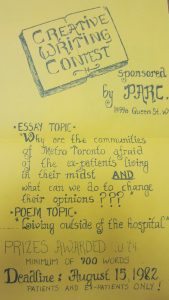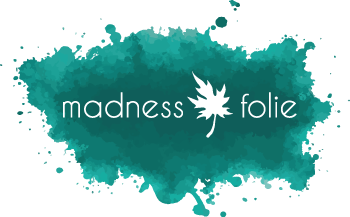Writing Group
The Writing Group, the oldest of PARC’s art groups, started in 1988. For thirty-two years, PARC writers have come together to sit around a table, respond to a given prompt, and write for twenty minutes. While the form has stayed consistent, PARC has grown and changed around the writing group. The writing stands as an articulate and passionate account of the PARC community and the lives of those who have passed through its doors.
Some of this writing can be found in PARC newsletters and in two published collections of writing: Kiss Me You Mad Fool (1991), and Let’s Face It! (2011). These publications transport the personal views and histories of members well beyond the walls of PARC. The first book includes a series of authors’ portraits taken by then staff person David Littman and developed in PARC’s on-site dark room. You can read a Kiss Me You Mad Fool poem about the writing group or pursue a short prose piece from Let’s Face It!. The second volume brings together PARC writers and visual artists between its covers. Many Writing Group members have also participated in Poetry Nights and Special Event Nights over the years.
Let’s Face It! Book Launch Photos, November 2011:
In the introduction to the first collection, Hume Cronyn describes the dreary environment at PARC when he first arrived:
Listless figures were hunched over tables, cigarette smoke rose to the ceiling and hung in clouds, the silence was only interrupted by fits of coughing, the grey walls seemed to press in.
Six years later, though, he describes PARC in a different light:
…the interior has been repainted a variety of colours by members, kites hang from the ceiling, the harsh fluorescent lights have been replaced, and the walls are covered with maps, posters, collages and photographs. Where there used to be silence, there is laughter and talking and, most important, listening.
 In the his introduction to Let’s Face It, published twenty years after the first book, Hume notes that in the ten years it took to put the book together, the writing group has met in three different rooms “somewhat mirroring the changes at PARC.” The first location was in old food bank with an odd assortment of tables and chairs. The group then moved to a storage cupboard on the second floor, cluttered by hockey equipment and a box of bathing suits: “One small window let in natural light, and on dark days an antique floor lamp that continually shorted provided sporadic light.” Following renovations, the group moved to the Edmond Yu room, named after a PARC member who was tragically shot and killed by police. Following publication of their second book, another series of renovations shifted the group once again, this time to the Healing Room, its large open windows letting in the sound of the world outside as the group scribbles away.
In the his introduction to Let’s Face It, published twenty years after the first book, Hume notes that in the ten years it took to put the book together, the writing group has met in three different rooms “somewhat mirroring the changes at PARC.” The first location was in old food bank with an odd assortment of tables and chairs. The group then moved to a storage cupboard on the second floor, cluttered by hockey equipment and a box of bathing suits: “One small window let in natural light, and on dark days an antique floor lamp that continually shorted provided sporadic light.” Following renovations, the group moved to the Edmond Yu room, named after a PARC member who was tragically shot and killed by police. Following publication of their second book, another series of renovations shifted the group once again, this time to the Healing Room, its large open windows letting in the sound of the world outside as the group scribbles away.
Hume himself questioned this writing practice itself its early years:
What use is writing once a week for an hour when many of our members suffer from deplorable living conditions; where meals in the boarding houses where most of our members live consist of cornflakes with hot water for breakfast, jam sandwiches for dinner or cold noodles with mashed potatoes; where they are harassed, beaten up, taunted by landlords, shopkeepers, school children; where they have no winter coat for sub-zero weather; where years and years of medication causes constant headaches, twitching, unbearable itchiness; where voices from the past and the future, fears, and anxieties create havoc in the head?
Yet Hume went on to reflect:
When I read these pieces, I am abhorred by the cruelty of life and its unseemingly irrationationality, but, at the same time, being brought face to face with the real conditions of their lives forces me to examine my life and reshape it. However, there’s another side to this book. There are pieces that shatter stereotypes, that celebrate and affirm life, that exude an aura of light and hope from the most mundane experience to the most universal, all-embracing gesture.


